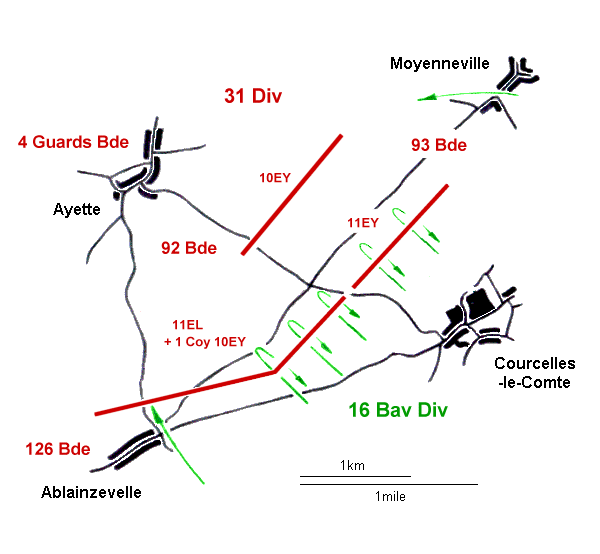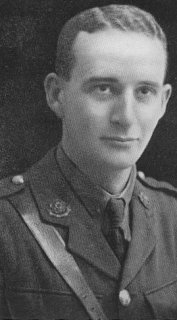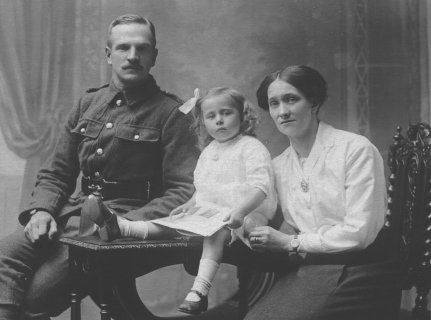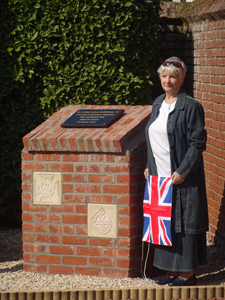
Breakthrough on the Somme On 21st March 1918, the German Seventeenth, Second and Eighteenth Armies were launched against the British lines on a 54-mile (86km) front from Arras to la Fère. In a bold attempt to punch through the lines and to drive the British armies north to the Channel, the Germans threw 500,000 troops against 160,000 men of the right wing of the British 3rd Army and the British 5th Army.
Above left: 2/Lt. Basil Arthur Horsfall VC Above right: Albert Walton, with his wife, Edith Charlotte, and daughter, Irene. Albert was from Nelson and was wounded in action with the 11th East Lancashires at Ayette on 27th March 1918. Photograph by kind courtesy of Albert's grandson, David Holman. Although the 3rd Army stood its ground well, the attack to the south forced the overstretched 5th Army to concede up to 4.5 miles (7km) of ground on the first day of the offensive; 21,000 British troops were taken prisoner. Despite intensely-fought rearguard actions, the 5th Army was compelled to fall back day after day. Within 48 hours, the Germans had thrown 750,000 men into the battle. The 3rd Army, which continued to withstand the onslaught, was forced to drop back to safeguard its right flank as the 5th Army retreated. Five French divisions were brought in to reinforce the southern end of the line on 23rd March; still the retreat continued. On 25th March, the 5th Army was pushed back across the 1916 Somme battlefield. The following day saw Albert fall to the enemy but, on the 27th, the 5th Army finally held its line. The Defence of Ayette 31st Division, comprising three brigades - the 92nd, 93rd and 4th Guards - had been deployed in the 3rd Army sector within 48 hours of the start of the offensive. Over 24th-26th March, the constant threat of the Division's right wing being turned forced a series of withdrawals. Dawn on 27th March found 92nd Brigade on the right flank of 31st Division in front of the village of Ayette, 9 miles (15km) south of Arras. At the front of the Brigade, the 11th East Yorkshire Regt. (Hull Tradesmen) and the 11th East Lancashire Regt. (Accrington Pals) held the ridge east of the Ablainzevelle-Moyenneville road, while the 10th East Yorkshire Regt. (Hull Commercials) was held in reserve. The situation was already critical; the left flank of the Brigade was under threat from German troops advancing through Moyenneville, no wire was available to protect the line, and the right flank was severely stretched by the need to keep in touch with 126th Brigade to the south. To make matters worse, the Brigade's positions had been hit by short-falling British artillery fire during the previous afternoon and night.  Following an intense artillery bombardment, the German 16th Bavarian Division made its first infantry attack on the 92nd Brigade front at 11.17am. After more than 30 minutes of desperate fighting at close range - during which the 11th East Yorkshires were forced back - the entire Brigade line was restored by a local counter-attack. The attacks were renewed at noon and at 12.20pm. At around this time, the forward sections of 2/Lt. Horsfall's platoon at the centre-left of the East Lancashires' front were driven back from the crest of the ridge. Although Horsfall had been severely wounded in the head, he immediately organised the remainder of his men and successfully counter-attacked to recover the original position. On hearing that of the remaining three officers of his company two had been killed and one wounded, he refused to go to the dressing station. Later his platoon had to fall back to escape very heavy shell fire but, as soon as the shelling lifted, he made a second counter-attack and again recovered the position. In the early afternoon, considerable German forces were seen to be collecting in Ablainzevelle, posing a serious threat to the right flank of the Brigade. A company of the 10th East Yorkshires was sent forward in support but was stopped short by heavy machine-gun fire from the village. By 2.40pm the Germans had gained a foothold on the ridge at the junction of the two forward battalions. The remainder of the supporting 10th East Yorkshire Regt. was used up in a successful counter-attack. As late in the afternoon as 3.45pm, hopes remained high that the Brigade's position could be held. Finally, however, the pressure told and both flanks gave way. By 4.25pm, 92nd Brigade's situation finally became untenable; with telephone wires hopelessly cut and with mist rendering signalling impossible, Lt.-Col. Rickman - as the senior officer on the spot - informed Divisional Headquarters by pigeon of his decision to withdraw the Brigade. Horsfall was the last East Lancashire officer to leave his position and, although exhausted, said he could have held on. This gallant officer was killed during the retirement. In their stubborn defence of Ayette, 350 officers and men of the 11th East Lancashire Regt. were killed, wounded or missing. The casualty list would have been longer still had it not been for the gallantry of Lewis gunners led by 2/Lt. Herbert Laycock who covered the retirement of the wounded and M.O.'s staff. The Offensive Halted The 11th East Lancashires took no further part in the first German offensive of 1918. Strong German attacks on the 3rd Army front on 28th March were repelled, and on 5th April Ludendorff called off the Somme offensive. Four days later, the Germans would attempt a fresh breakthrough on a 10-mile (16km) front to the north: the Battle of the Lys would again see the 11th East Lancashires in the front line. Ayette Today A convenient route to the battlefield is to leave the N37 Arras to Bapaume road at Ervillers, following signs to the nearby village of Courcelles-le-Comte. On reaching the village, turn left into the main road towards Bucquoy. Near the end of the village, turn right down a minor road signposted to Ayette. The road initially curves downhill before climbing up the low ridge held by 92nd Brigade on 27th March. At the crest of the ridge, park close to where the road intersects a track. This is roughly where the forward positions of the 11th East Lancashires and the 11th East Yorkshires met. A fine panorama of the battlefield can be seen by walking some 50 yards along the track to the south-west, close to the point where 2/Lt. Horsfall's platoon fought so valiantly. The road can be followed on to Ayette, from where Serre is only 5 miles away along the D919. Memorial to Horsfall VC at Ablainzevelle
© Andrew C Jackson 1999, 2019 Compiled from TNA documents WO95/2356, WO95/2357, WO95/2358, WO95/2366 and WO339/45724, CWGC records, and "The History of the East Lancashire Regiment in the Great War" edited by Major General Sir N. Nicholson.
|


